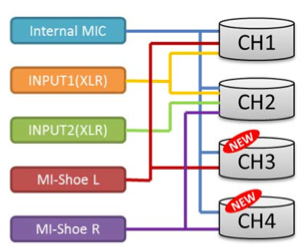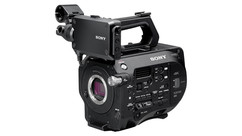
EDIT: Sony FS7 firmware v2.0 is now available for download from the Sony Community Site.
One of the many updates is support for 4K (4096x2160) XAVC-I recording. Many refer to this as true DCI 4K recording, as it is ideal for projects that will be shown in theaters that have DCI compliant 4K projectors and a 17x9 theatrical aspect ratio screen. Other applications of this 4069x2160p frame and resolution size include recording 4K plates and stock footage that can be used by feature movie companies looking for specific niche locations or subjects. The chart below shows the frame rates and bit rates available with the new firmware:
This firmware now enables one of the most anticipated features of the optional XDCA-FS7 module, namely the ability to encode and write ProRes files to a single internal XQD card. ProRes will now be available with HD 422HQ and ProRes 422 options. This is very useful for accommodating post houses and clients that prefer the ProRes workflow for their end deliverable. The following chart lists the formats, resolution, codec wrapper and frame rates that are now available:
It should be noted that when ProRes is selected for recording, simultaneous recording to both XQD cards is not possible. S+Q recording, as well as Picture Cache Rec, is not supported as well.
Finally, one of the most requested features by our existing FS7 customers has been included in this firmware upgrade - 4-channel recording capability. Those who are XAVC codec savvy may know that it supports up to 8 channels of audio recording. The ability to record an additional 2 channels on the FS7 is very useful for many shooting scenarios and applications.
With the firmware V2.0 update, FS7 owners will now be able to select and record up to 4 channels of audio in very flexible ways.

Users are now able to assign an attached UWP-D wireless audio receiver to an FS7 via a SMAD-P3 and assign the mono channel from the receiver to channels for internal recording, one at a normal level and one at a "Safety" 8-12dB lower level. In addition, users can utilize the first XLR jack to feed an on-camera mono microphone that can also be set to have bracketed levels, or a stereo on-camera microphone could be plugged into both XLR-jacks and employed for recording just location ambient sounds.
For those who prefer to run all their microphones wired directly back to their camera, the new firmware 2.0 allows a Sony XLR-K2M Multi-Interface shoe XLR module to now be added to the FS7's multi-interface shoe position. The XLR-K2M has individual level controls for each XLR channel, and it even has the ability to provide phantom power to both jacks, allowing four separate mics to be powered off a single FS7 camera.
This module will also allow for multiple isolated tracks or mix track audio channels from a sound mixer to be recorded directly onto the XQD card via a ENG audio snake cable, or even four channels of wireless audio camera hop channels.
For those who want to keep things simple, it is now possible to have the built-in camera scratch mic selected to record all the time voice memos from the operator, while the other three channels can be used for the UWP-D receiver's two channels and a single channel for an on camera shotgun microphone. This great array of choices in audio will fulfill the needs of a one-person operator all the way to a complex multi talent interview panel.
Finally, Sony's FS7 engineers have also provided fixes to issues that have been reported back to them by FS7 customers in the field:
- An elimination of what many described as a "Magenta Cast" in white balance preset mode
- The ability to rename the Color Temp <P> menu parameter to: "Preset White"
- "Steadyshot" no longer needs to be re-enabled after an power on/off cycle
- Retention of "Paint Menu" settings after powering the camera on and off




















